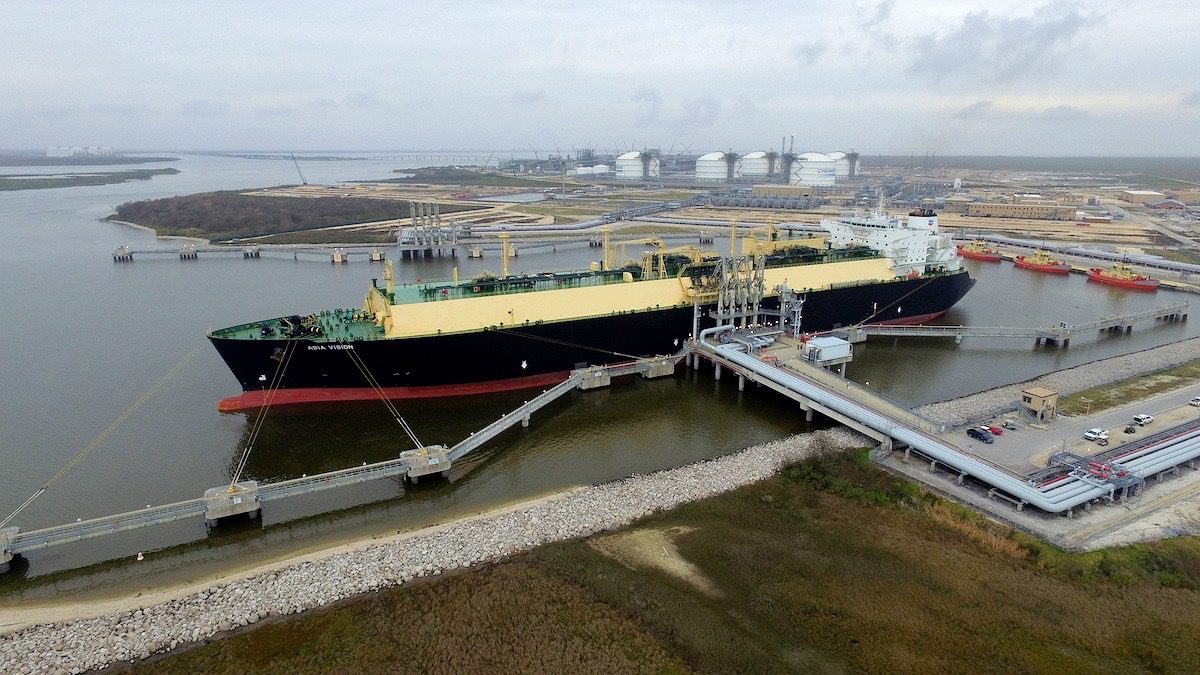Loading of the first commissioning cargo at the Sabine Pass LNG Terminal in February 2016. File photo: Cheniere Energy
By Naureen S. Malik (Bloomberg) — Wearing a hardhat and orange vest, Ari Aziz climbs metal steps under a blazing sun until he’s standing atop an 180-foot-high tank in Corpus Christi, Texas. It’s big enough, he proudly points out, to hold a jumbo jet placed diagonally.
Aziz is supervising more than 100 workers who form a kind of SWAT team for Cheniere Energy Inc. They’re checking every valve and pipe that feeds the sparkling new tank. On Wednesday, Cheniere said it started producing liquefied natural gas for the first time at the plant. It plans to fill up the tank with 43 million gallons of super-chilled LNG that’s slated to be shipped to gas-hungry countries like China — a rosy prospect unless trade tensions escalate between the world’s two biggest economies.
Less than three years ago, the lower 48 states exported zero LNG. Now, there’s an abundance of domestic gas from shale, and it’s still relatively cheap, despite the spike in U.S. futures prices on Wednesday. America is shipping more abroad, moving the country closer to becoming a global gas power. That means greater influence in setting prices, and in new markets for domestic producers struggling with an overabundance.
Trade War
The dark cloud throwing its shadow over this historic development is the 10 percent Chinese tariff on U.S. LNG cargoes, imposed in September after the Trump administration levied tariffs on some Chinese goods. The industry’s looming fear is that come January, China will raise the LNG levy to 25 percent, essentially wiping out the discount for buying super cheap shale gas, according to the Center for Liquefied Natural Gas, a Washington industry group.
China is shifting to natural gas from Russia, a trend that could accelerate and drag European buyers into the turmoil. The question is whether the growing U.S. supply of LNG will be cheap enough to reduce Europe’s reliance on piped Russian gas, a move urged by President Donald Trump as a tool to weaken Russia’s influence.
Still, the first tanker carrying U.S. LNG since the tariff was imposed made it to China earlier this week. Sales to the country are up more than 50 percent year over year “and that’s not slowing down,’’ Cheniere Chief Executive Officer Jack Fusco said in an interview at the company’s Houston headquarters. “Our product is extremely hot.’’
Export Sites
The new $15 billion Corpus Christi terminal marks Cheniere’s second LNG export site — they have another on Louisiana’s Gulf Coast — and the third in the continental U.S., counting Dominion Energy Inc.’s terminal in Maryland. In the next two years, the U.S. is slated to have six operating terminals, accounting for 17 percent of global capacity. That would make it the world’s third-largest LNG supplier after Qatar and Australia.
Fusco said he expects China to continue to buy U.S. LNG, noting Cheniere already has a contract to deliver it this winter to state-backed China National Petroleum Corp. A company spokesman declined to comment on the prospect of higher tariffs.
More than a decade in the making, Cheniere’s Corpus Christi plant tells the tale of the changing fortunes of the natural gas business. It was conceived as a terminal to import fuel, but the domestic shale boom scrapped those plans and the site stood vacant for years.
Shale Boom
In 2012, the company began revamping it as an export facility when it became apparent the shale boom was flooding the U.S. with excess gas, pushing down prices. The plant will rely in part on piped gas from the nearby Permian that’s produced as a byproduct of oil fracking. The gas is chilled to 260 degrees below zero Fahrenheit (minus 162 Celsius), turning it into a liquid that can be shipped overseas on tankers.
Demand for natural gas is growing globally partly for environmental reasons. It’s a fossil fuel, but it burns cleaner than oil or coal. Global LNG demand is on track to climb 8.5 percent this year to 308 million tons from last year, and surge to 450 million tons by 2030, according to Bloomberg NEF.
“The shale revolution in the U.S. changed the whole picture because we were an importing country and we are now an exporting country,” said Zhen Zhu, an economist with engineering and consulting firm C.H. Guernsey in Oklahoma City. “We’re now experiencing that fundamentally changing the whole market.”
Price Fluctuations
In the short term, Cheniere will have to navigate pricing challenges. The U.S. is heading into winter with the lowest stockpiles in 15 years. That threatens to send gas prices spiking during a cold snap, potentially dissuading buyers in Europe or Asia.
But Fusco sees demand growing long term, justifying plans to expand the Corpus Christi site. Earlier this year, the company gave the green light to build a third liquefaction plant there.
“I believe we can double the size of the company fairly easily,” Fusco said.
He’s got one other goal: to get the company’s stock into the S&P 500 Index. Cheniere’s shares have surged more than 150 percent since a low in February 2016, giving it a market capitalization of more than $15 billion.
“The S&P 500 would be nice,” he said.
© 2018 Bloomberg L.P

 Join The Club
Join The Club











